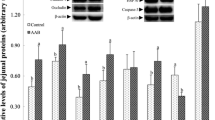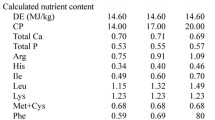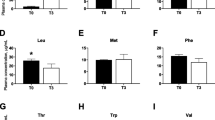Abstract
This study determined the effects of dietary branched-chain amino acids (AA) (BCAA) on growth performance, expression of jejunal AA and peptide transporters, and the colonic microflora of weanling piglets fed a low-protein (LP) diet. One hundred and eight Large White × Landrace × Duroc piglets (weaned at 28 days of age) were fed a normal protein diet (NP, 20.9 % crude protein), an LP diet (LP, 17.1 % crude protein), or an LP diet supplemented with BCAA (LP + BCAA, 17.9 % crude protein) for 14 days. Dietary protein restriction reduced piglet growth performance and small-intestinal villous height, which were restored by BCAA supplementation to the LP diet to values for the NP diet. Serum concentrations of BCAA were reduced in piglets fed the LP diet while those in piglets fed the LP + BCAA diet were similar to values for the NP group. mRNA levels for Na+-neutral AA exchanger-2, cationic AA transporter-1, b0,+ AA transporter, and 4F2 heavy chain were more abundant in piglets fed the LP + BCAA diet than the LP diet. However, mRNA and protein levels for peptide transporter-1 were lower in piglets fed the LP + BCAA diet as compared to the LP diet. The colonic microflora did not differ among the three groups of pigs. In conclusion, growth performance, intestinal development, and intestinal expression of AA transporters in weanling piglets are enhanced by BCAA supplementation to LP diets. Our findings provide a new molecular basis for further understanding of BCAA as functional AA in animal nutrition.



Similar content being viewed by others
Abbreviations
- ADFI:
-
Average daily feed intake
- ADG:
-
Average daily gain of body weight
- ASCT2:
-
Na+-neutral AA exchanger 2
- BCAA:
-
Branched-chain amino acids
- B0AT1:
-
System B0 neutral AA transporter
- CAT1:
-
Cationic amino acid transporter 1
- CP:
-
Crude protein
- DGGE:
-
Denaturing gradient gel electrophoresis
- 4F2hc:
-
4F2 heavy chain
- LP:
-
Low protein
- mTOR:
-
Mammalian target of rapamycin
- NP:
-
Normal protein
- PepT-1:
-
Peptide transporter 1
- rBAT:
-
Related to b0,+ amino acid transporter
- RT-PCR:
-
Real-time polymerase chain reaction
- VFA:
-
Volatile fatty acids
References
AOAC (2003) Official methods of analysis. Association of Official Analytical Chemists, Arlington
Armstrong WD, Cline T (1976) Effects of various dietary nutrient levels on the incidence of colibacillary diarrhea in pigs: intestinal ligation studies. J Anim Sci 42:592–598
Baker DH (2009) Advances in protein-amino acid nutrition of poultry. Amino Acids 37:29–41
Bergen WG, Wu G (2009) Intestinal nitrogen recycling and utilization in health and disease. J Nutr 139(5):821–825
Bertrand J, Goichon A, Déchelotte P et al (2013) Regulation of intestinal protein metabolism by amino acids. Amino Acids 45:443–450
Blachier F, Lancha AH Jr, Boutry C et al (2010) Alimentary proteins, amino acids and cholesterolemia. Amino Acids 38:15–22
Bröer S (2008) Amino acid transport across mammalian intestinal and renal epithelia. Physiol Rev 88:249–286
Brosnan JT, Brosnan ME (2013) Glutamate: a truly functional amino acid. Amino Acids 45:413–418
Brudevold A, Southern L (1994) Low-protein, crystalline amino acid-supplemented, sorghum-soybean meal diets for the 10-to 20-kilogram pig. J Anim Sci 72:638–647
Chen H, Pan YX, Wong EA et al (2005) Dietary protein level and stage of development affect expression of an intestinal peptide transporter (cPepT1) in chickens. J Nutr 135:193–198
Chen LX, Yin YL, Jobgen WS et al (2007) In vitro oxidation of essential amino acids by intestinal mucosal cells of growing pigs. Livest Sci 109:19–23
Chen LX, Li P, Wang JJ et al (2009) Catabolism of nutritionally essential amino acids in developing porcine enterocytes. Amino Acids 37:143–152
Closs E, Boissel JP, Habermeier A et al (2006) Structure and function of cationic amino acid transporters (CATs). J Membr Biol 213:67–77
Dai ZL, Zhang J, Wu G et al (2010) Utilization of amino acids by bacteria from the pig small intestine. Amino Acids 39:1201–1215
Dai ZL, Wu G, Zhu WY (2011) Amino acid metabolism in intestinal bacteria: links between gut ecology and host health. Front Biosci 16:1768–1786
Dai ZL, Li XL, Xi PB et al (2012a) Regulatory role for l-arginine in the utilization of amino acids by pig small-intestinal bacteria. Amino Acids 43:233–244
Dai ZL, Li XL, Xi PB et al (2012b) Metabolism of select amino acids in bacteria from the pig small intestine. Amino Acids 42:1597–1608
Dai ZL, Li XL, Xi PB et al (2013) l-Glutamine regulates amino acid utilization by intestinal bacteria. Amino Acids 45:501–512
Daniel H (2004) Molecular and integrative physiology of intestinal peptide transport. Annu Rev Physiol 66:361–384
Deng D, Yin YL, Chu WY et al (2009) Impaired translation initiation activation and reduced protein synthesis in weaned piglets fed a low-protein diet. J Nutr Biochem 20:544–552
Dillon EL (2013) Nutritionally essential amino acids and metabolic signaling in aging. Amino Acids 45:431–441
Drummond MJ, Glynn EL, Fry CS et al (2010) An increase in essential amino acid availability upregulates amino acid transporter expression in human skeletal muscle. Am J Physiol Endocrinol Metab 298:E1011–E1018
Escobar J, Frank JW, Suryawan A (2006) Regulation of cardiac and skeletal muscle protein synthesis by individual branched-chain amino acids in neonatal pigs. Am J Physiol Endocrinol Metab 290:E612–E621
Fernstrom JD (2013) Large neutral amino acids: dietary effects on brain neurochemistry and function. Amino Acids 45:419–430
Figueroa J, Lewis A, Miller P et al (2003) Growth, carcass traits, and plasma amino acid concentrations of gilts fed low-protein diets supplemented with amino acids including histidine, isoleucine, and valine. J Anim Sci 81:1529–1537
Franklin M, Mathew A, Vickers J et al (2002) Characterization of microbial populations and volatile fatty acid concentrations in the jejunum, ileum, and cecum of pigs weaned at 17 vs 24 days of age. J Anim Sci 80:2904–2910
Fu WJ, Stromberg AJ, Viele K et al (2010) Statistics and bioinformatics in nutritional sciences: analysis of complex data in the era of systems biology. J Nutr Biochem 21:561–572
Galfi P, Bokori J (1990) Feeding trial in pigs with a diet containing sodium n-butyrate. Acta Vet Hung 38:3–17
Gilbert ER, Li H, Emmerson DA et al (2008) Dietary protein quality and feed restriction influence abundance of nutrient transporter mRNA in the small intestine of broiler chicks. J Nutr 138:262–271
He LQ, Yang HS, Li TJ et al (2013) Effects of dietary l-lysine intake on the intestinal mucosa and expression of CAT genes in weaned piglets. Amino Acids 45:383–391
Hou YQ, Wang L, Zhang W et al (2012) Protective effects of N-acetylcysteine on intestinal functions of piglets challenged with lipopolysaccharide. Amino Acids 43:1233–1242
Hou YQ, Wang L, Yi D et al (2013) N-Acetylcysteine reduces inflammation in the small intestine by regulating redox, EGF and TLR4 signaling. Amino Acids 45:513–522
Ihara T, Tsujikawa T, Fujiyama Y et al (2000) Regulation of PepT1 peptide transporter expression in the rat small intestine under malnourished conditions. Digestion 61:59–67
Kanai Y, Hediger MA (2003) The glutamate and neutral amino acid transporter family: physiological and pharmacological implications. Eur J Pharmacol 479:237–247
Kelly D, Smyth J, McCracken K (1991) Digestive development of the early-weaned pig. Brit J Nutr 65:181–188
Laspiur JP, Burton JL, Weber PSD et al (2009) Dietary protein intake and stage of lactation differentially modulate amino acid transporter mRNA abundance in porcine mammary tissue. J Nutr 139:1677–1684
Le Plenier S, Walrand S, Noirt R et al (2012) Effects of leucine and citrulline versus non-essential amino acids on muscle protein synthesis in fasted rat: a common activation pathway? Amino Acids 43:1171–1178
Lei J, Feng DY, Zhang YL et al (2012a) Regulation of leucine catabolism by metabolic fuels in mammary epithelial cells. Amino Acids 43:2179–2189
Lei J, Feng DY, Zhang YL et al (2012b) Nutritional and regulatory role of branched-chain amino acids in lactation. Front Biosci 17:2725–2739
Lei J, Feng DY, Zhang YL et al (2013) Hormonal regulation of leucine catabolism in mammary epithelial cells. Amino Acids 45:531–541
Leibach FH, Ganapathy V (1996) Peptide transporters in the intestine and the kidney. Annu Rev Nutr 16:99–119
Li P, Yin YL, Li DF et al (2007) Amino acids and immune function. Br J Nutr 98:237–252
Li FN, Yin YL, Tan BE et al (2011a) Leucine nutrition in animals and humans: mTOR signaling and beyond. Amino Acids 41:1185–1193
Li XL, Rezaei R, Li P et al (2011b) Composition of amino acids in feed ingredients for animal diets. Amino Acids 40:1159–1168
Lordelo M, Gaspar A, Le Bellego L et al (2008) Isoleucine and valine supplementation of a low-protein corn–wheat–soybean meal-based diet for piglets: growth performance and nitrogen balance. J Anim Sci 86:2936–2941
Murakami H, Ito M, Furukawa Y et al (2012) Leucine accelerates blood ethanol oxidation by enhancing the activity of ethanol metabolic enzymes in the livers of SHRSP rats. Amino Acids 43:2545–2551
Muyzer G, De Waal EC, Uitterlinden AG (1993) Profiling of complex microbial populations by denaturing gradient gel electrophoresis analysis of polymerase chain reaction-amplified genes coding for 16S rRNA. Appl Environ Microb 59:695–700
NRC (1998) Nutrient requirements of swine. National Academy Press, Washington, DC
NSNG (2010) National Swine Nutrition Guide. Tables on nutrient recommendations, ingredient composition, and use rates. US Pork Center of Excellence, Ames
Opapeju F, Krause D, Payne R et al (2009) Effect of dietary protein level on growth performance, indicators of enteric health, and gastrointestinal microbial ecology of weaned pigs induced with postweaning colibacillosis. J Anim Sci 87:2635–2643
Palacín M, Kanai Y (2004) The ancillary proteins of HATs: SLC3 family of amino acid transporters. Pflugers Arch 447:490–494
Pluske JR, Thompson MJ, Atwood CS et al (1996) Maintenance of villus height and crypt depth, and enhancement of disaccharide digestion and monosaccharide absorption, in piglets fed on cows’ whole milk after weaning. Br J Nutr 76:409–422
Prasad PD, Wang H, Huang W et al (1999) Human LAT1, a subunit of system L amino acid transporter: molecular cloning and transport function. Biochem Biophys Res Commun 255:283–288
Ren WK, Luo W, Wu MM et al (2013) Dietary l-glutamine supplementation improves pregnancy outcome in mice infected with type-2 porcine circovirus. Amino Acids 45:479–488
Rezaei R, Wang WW, Wu ZL et al (2013a) Biochemical and physiological bases for utilization of dietary amino acids by young pigs. J Anim Sci Biotechnol 4:7
Rezaei R, Knabe DA, Tekwe CD et al (2013b) Dietary supplementation with monosodium glutamate is safe and improves growth performance in postweaning pigs. Amino Acids 44:911–923
Rhoads JM, Wu G (2009) Glutamine, arginine, and leucine signaling in the intestine. Amino Acids 37:111–122
San Gabriel A, Uneyama H (2013) Amino acid sensing in the gastrointestinal tract. Amino Acids 45:451–461
Satterfield MC, Dunlap KA, Keisler DH et al (2013) Arginine nutrition and fetal brown adipose tissue development in nutrient-restricted sheep. Amino Acids 45:489–499
Suryawan A, Davis TA (2011) Regulation of protein synthesis by amino acids in muscle of neonates. Front Biosci 16:1445–1460
Suryawan A, Nguyen HV, Almonaci RD et al (2013) Abundance of amino acid transporters involved in mTORC1 activation in skeletal muscle of neonatal pigs is developmentally regulated. Amino Acids 45:523–530
Tan B, Yin Y, Kong X et al (2010) l-Arginine stimulates proliferation and prevents endotoxin-induced death of intestinal cells. Amino Acids 38:1227–1235
Tan BE, Li XG, Wu G et al (2012) Dynamic changes in blood flow and oxygen consumption in the portal-drained viscera of growing pigs receiving acute administration of l-arginine. Amino Acids 43:2481–2489
Torras-Llort M, Soriano-Garcia J, Ferrer R et al (1998) Effect of a lysine-enriched diet on l-lysine transport by the brush-border membrane of the chicken jejunum. Am J Physiol 274:R69–R75
van Beers-Schreurs HMG, Nabuurs MJA, Vellenga L et al (1998) Weaning and the weanling diet influence the villous height and crypt depth in the small intestine of pigs and alter the concentrations of short-chain fatty acids in the large intestine and blood. J Nutr 128:947–953
Wang JJ, Chen LX, Li P et al (2008) Gene expression is altered in piglet small intestine by weaning and dietary glutamine supplementation. J Nutr 138:1025–1032
Wang W, Qiao S, Li D (2009) Amino acids and gut function. Amino Acids 37:105–110
Wang W, Zeng X, Mao X et al (2010) Optimal dietary true ileal digestible threonine for supporting the mucosal barrier in small intestine of weanling pigs. J Nutr 140:981–986
Wang X, Zeng P, Feng Y et al (2012a) Effects of dietary lysine levels on apparent nutrient digestibility and cationic amino acid transporter mRNA abundance in the small intestine of finishing pigs, Sus scrofa. Anim Sci J 83:148–155
Wang Y, Zhang L, Zhou G et al (2012b) Dietary l-arginine supplementation improves the intestinal development through increasing mucosal Akt and mammalian target of rapamycin signals in intra-uterine growth retarded piglets. Br J Nutr 108:1371–1381
Wang WW, Wu ZL, Dai ZL et al (2013) Glycine metabolism in animals and humans: implications for nutrition and health. Amino Acids 45:463–477
Wei JW, Carroll RJ, Harden KK et al (2012) Comparisons of treatment means when factors do not interact in two-factorial studies. Amino Acids 42:2031–2035
Wu G (2009) Amino acids: metabolism, functions, and nutrition. Amino Acids 37:1–17
Wu G (2010a) Recent advances in swine amino acid nutrition. J Anim Sci Biotech 1:49–61
Wu G (2010b) Functional amino acids in growth, reproduction and health. Adv Nutr 1:31–37
Wu G (2013a) Amino acids: biochemistry and nutrition. CRC Press, Boca Raton
Wu G (2013b) Functional amino acids in nutrition and health. Amino Acids 45:407–411
Wu X, Ruan Z, Gao Y et al (2010) Dietary supplementation with l-arginine or N-carbamylglutamate enhances intestinal growth and heat shock protein-70 expression in weanling pigs fed a corn-and soybean meal-based diet. Amino Acids 39:831–839
Wu G, Bazer FW, Johnson GA et al (2011a) Important roles for l-glutamine in swine nutrition and production. J Anim Sci 89:2017–2030
Wu G, Bazer FW, Burghardt RC et al (2011b) Proline and hydroxyproline metabolism: implications for animal and human nutrition. Amino Acids 40:1053–1063
Wu G, Bazer FW, Satterfield MC et al (2013a) Impacts of arginine nutrition on embryonic and fetal development in mammals. Amino Acids 45:241–256
Wu G, Wu ZL, Dai ZL et al (2013b) Dietary requirements of “nutritionally nonessential amino acids” by animals and humans. Amino Acids 44:1107–1113
Yin FG, Liu YL, Yin YL et al (2009) Dietary supplementation with Astragalus polysaccharide enhances ileal digestibilities and serum concentrations of amino acids in early weaned piglets. Amino Acids 37:263–270
Yin Y, Yao K, Liu Z et al (2010) Supplementing l-leucine to a low-protein diet increases tissue protein synthesis in weanling pigs. Amino Acids 39:1477–1486
Zentek J, Fricke S, Hewicker-Trautwein M, Ehinger B, Amtsberg G, Baums C (2004) Dietary protein source and manufacturing processes affect macronutrient digestibility, fecal consistency, and presence of fecal Clostridium perfringens in adult dogs. J Nutr 134(8 Suppl):2158S–2161S
Acknowledgments
This research was supported by National Key Basic Research Program (2012CB124704 and 2013CB127302), NSFC (31272217 and 31272450), Chinese Universities Scientific Funds (2012RC024), and the Thousand-People-Talent program at China Agricultural University, and Texas AgriLife Research (No. 8200).
Conflict of interest
The authors declare no conflicts of interest.
Author information
Authors and Affiliations
Corresponding authors
Rights and permissions
About this article
Cite this article
Zhang, S., Qiao, S., Ren, M. et al. Supplementation with branched-chain amino acids to a low-protein diet regulates intestinal expression of amino acid and peptide transporters in weanling pigs. Amino Acids 45, 1191–1205 (2013). https://doi.org/10.1007/s00726-013-1577-y
Received:
Accepted:
Published:
Issue Date:
DOI: https://doi.org/10.1007/s00726-013-1577-y




